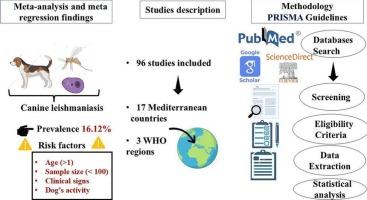Seroprevalence and risk factors of canine leishmaniasis in Mediterranean countries: A systematic review and meta-analysis (2000–2024)
IF 1.8
3区 农林科学
Q1 VETERINARY SCIENCES
引用次数: 0
Abstract
Caused by Leishmania infantum, canine leishmaniasis (CanL) is endemic in the Mediterranean basin and can threaten public health. We conducted a systematic review and meta-analysis to summarize and standardize existing knowledge about CanL in the Mediterranean by determining global prevalence recorded in the last decades and the potential risk factors associated. According to the PRISMA (Preferred Reporting Items for Systematic Reviews and Meta-Analyzes) protocol, systematic searches were conducted in three databases: PubMed, Google Scholar, and Science Direct. Between 2000 and 2024, ninety-six eligible publications were selected, and statistically analyzed. The pooled overall CanL seroprevalence was 16.12 % (14,351/134752, 95 % Cl: 13.27–19.18). The highest prevalence rate of 21.73 % (95 % Cl: 15.49–28.69) was reported in the African continent and followed by Southern and Middle Eastern countries. Age, sample size, clinical status and dog's activity were revealed as risk factors associated with CanL (p < 0.0001). The highest prevalence was observed in older dogs (>1 year) (18.72 %; 95 % Cl: 12.73–25.54), sample size <100 (26.82 %, 95 % Cl: 16.56–37.11), presence of clinical signs (30.39 %, 95 % CI: 18.53–43.65) and farming dogs (23.89 %, 95 % Cl: 12.50–37.36). However, no statistical significance was found with sex, breed, WHO regions and the diagnostic methods. These interesting findings are needed to improve the monitoring and management of disease, especially in low-income countries, and to establish crucial control strategies to eradicate the disease across the Mediterranean area and eliminate the transmission risk to humans.

地中海国家犬利什曼病的血清患病率和危险因素:一项系统回顾和荟萃分析(2000-2024)
犬利什曼病(CanL)由幼利什曼原虫引起,是地中海盆地的一种地方性疾病,可威胁公众健康。我们进行了一项系统回顾和荟萃分析,通过确定过去几十年记录的全球患病率和相关的潜在危险因素,总结和标准化地中海地区关于CanL的现有知识。根据PRISMA(系统评价和元分析的首选报告项目)协议,系统检索在三个数据库中进行:PubMed,谷歌Scholar和Science Direct。在2000年至2024年期间,选择了96份符合条件的出版物,并进行了统计分析。CanL血清总阳性率为16.12% (14351 /134752,95% Cl: 13.27-19.18)。非洲大陆的患病率最高,为21.73% (95% Cl: 15.49-28.69),其次是南部和中东国家。年龄、样本量、临床状态和狗的活动被认为是与CanL相关的危险因素(p <;0.0001)。老年犬(1岁)患病率最高(18.72%;95% Cl: 12.73-25.54),样本量<;100 (26.82%, 95% Cl: 16.56-37.11),有无临床症状(30.39%,95% CI: 18.53-43.65)和农用犬(23.89%,95% Cl: 12.50-37.36)。但在性别、品种、WHO区域、诊断方法等方面均无统计学意义。需要这些有趣的发现来改善疾病的监测和管理,特别是在低收入国家,并制定关键的控制战略,以在整个地中海地区根除该疾病并消除对人类的传播风险。
本文章由计算机程序翻译,如有差异,请以英文原文为准。
求助全文
约1分钟内获得全文
求助全文
来源期刊

Research in veterinary science
农林科学-兽医学
CiteScore
4.40
自引率
4.20%
发文量
312
审稿时长
75 days
期刊介绍:
Research in Veterinary Science is an International multi-disciplinary journal publishing original articles, reviews and short communications of a high scientific and ethical standard in all aspects of veterinary and biomedical research.
The primary aim of the journal is to inform veterinary and biomedical scientists of significant advances in veterinary and related research through prompt publication and dissemination. Secondly, the journal aims to provide a general multi-disciplinary forum for discussion and debate of news and issues concerning veterinary science. Thirdly, to promote the dissemination of knowledge to a broader range of professions, globally.
High quality papers on all species of animals are considered, particularly those considered to be of high scientific importance and originality, and with interdisciplinary interest. The journal encourages papers providing results that have clear implications for understanding disease pathogenesis and for the development of control measures or treatments, as well as those dealing with a comparative biomedical approach, which represents a substantial improvement to animal and human health.
Studies without a robust scientific hypothesis or that are preliminary, or of weak originality, as well as negative results, are not appropriate for the journal. Furthermore, observational approaches, case studies or field reports lacking an advancement in general knowledge do not fall within the scope of the journal.
 求助内容:
求助内容: 应助结果提醒方式:
应助结果提醒方式:


